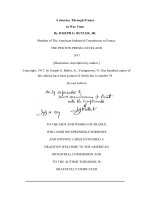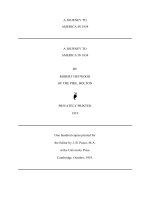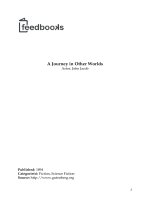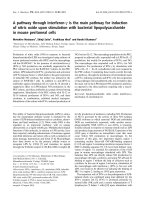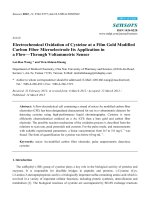invisible china a journey through ethnic borderlands
Bạn đang xem bản rút gọn của tài liệu. Xem và tải ngay bản đầy đủ của tài liệu tại đây (8.49 MB, 281 trang )
I
n this eloquent and eye-opening adven-
ture narrative, Colin Legerton and
Jacob Rawson, two Americans fluent
in Mandarin Chinese, Korean, and Uyghur,
throw away the guidebook and bring a hith-
erto unexplored side of China to light. They
journey over 14,000 miles by bus and train
to the farthest reaches of the country to
meet the minority peoples who dwell there,
talking to farmers in their fields, monks in
their monasteries, fishermen on their skiffs,
and herders on the steppe.
In Invisible China, they engage in a
heated discussion of human rights with
Daur and Ewenki village cadres; celebrate
Muhammad’s birthday with aging Dong-
xiang hajjis who recount the government’s
razing of their mosque; attend mass with
old Catholic Kinh fishermen at a church
that has been forty years without a priest;
hike around high-altitude Lugu Lake to
farm with the matrilineal Mosuo women;
and descend into a dry riverbed to hunt for
jade with Muslim Uyghur merchants. As
they uncover surprising facts about China’s
hidden minorities and their complex posi-
tion in Chinese society, they discover the
social ramifications of inconsistent gov-
ernment policies—and some deep human
truths as well.
Colin Legerton (right) graduated from
Tufts University with a degree in Chinese
language and literature. He spent a year in
Urumqi studying Uyghur and mentoring
western China’s only baseball team and later
produced Diamond in the Dunes, a documen-
tary film that tells their story. He has worked
as a Chinese- English translator and is currently
pursuing a master’s degree in Central Asian
studies at Indiana University, with a focus on
Uyghur literature.
Jacob Rawson (left) has lived and studied
in Yokohama and Beijing. After graduating
from Lewis and Clark College with a degree
in Chinese and Japanese languages, he taught
at a high school in rural South Korea as a Ful-
bright fellow. Now back in the United States,
he has given presentations on China’s ethnic
minorities and the Korean minority in Japan.
He is working toward a master’s degree in Chi-
nese and Korean linguistics at the University
of Washington.
Jacket design: Monica Baziuk
Front and back cover photos: Jacob Rawson
Author photo: Matt P. Jager
Printed in the United States of America
“ He’s singing about how happy he is to be home,” Teacher Ye explained as we
sidestepped together. She had given up her cymbals to one of the children, and
now was in the circle with the rest of us, leading the singing with her powerful
voice. “He’s a postman in the county seat. He and the others just came back from
there on the electric mule.” We swung our joined hands as we circled around
the postman. “They aren’t able to come home very often, so they’re always very
excited when they do get here. This song is very loose, so he can sing about any-
thing he wants, and then the rest of us respond to him. That way the song is always
from the heart.”
Finishing his song of joy, the postman invited us to join the music. He took a
drum from his friend and a pair of cymbals from one of the children, and gave
the instruments to us. Demonstrating on the gong, he encouraged us to imitate his
rhythm. We struggled to keep the beat, but the dancing circled around us anyway.
The children continued their refrain unaffected even when the percussion paused
for a quick lesson. “Just keep trying,” the postman encouraged. “You’ll get it.”
d
A Journey Through
Ethnic Borderlands
Invisible
China
C
olin
L
egerton
a nd
J
ac ob
R
awson
d
d
$24.95
(
c an $ 27.95
)
travel / asian studies
Invisible China
legerton
& rawson
d
d
Invisible
China
A Journey Through
Ethnic Borderlands
Invisible
China
C
olin
L
egerton
and
J
acob
R
awson
Library of Congress Cataloging-in-Publication Data
Legerton, Colin.
Invisible China : a journey through ethnic borderlands / Colin Legerton
and Jacob Rawson. — 1st ed.
p. cm.
Includes bibliographical references and index.
ISBN 978-1-55652-814-9
1. Minorities—China. 2. China—Description and travel. I. Rawson,
Jacob. II. Title.
DS730.L36 2009
305.800951—dc22
2008043666
Interior design: Monica Baziuk
Map design: Polly Fossey
© 2009 by Colin Legerton and Jacob Rawson
All rights reserved
First edition
Published by Chicago Review Press, Incorporated
814 North Franklin Street
Chicago, Illinois 60610
ISBN 978-1-55652-814-9
Printed in the United States of America
5 4 3 2 1
Contents
Acknowledgments
~
vii
Authors’ Note
~
ix
Introduction
~
1
I
The Northeast
1. Hunters of the Hinterlands:
The Oroqen, Daur, Ewenki, and Hezhen [17]
2. Immigrants and Emigrants: The Koreans [43]
3. The Windswept Kingdom: The Mongolians [61]
II
The Southwest
4. Fishermen of the South Sea: The Kinh [79]
5. Valley of the Headhunters: The Wa [99]
6. Selling Ethnicity: The Naxi [115]
7. The Country of Daughters: The Mosuo [129]
III
The Northwest
8. Left Behind: The Dongxiang [147]
9. Prayers on the Plateau: The Tibetans [161]
10. The Sweltering Oasis: The Uyghurs [177]
11. Yaks and Yurts: The Tajiks [195]
IV
The East
12. Chinese Jews? [211]
13. Final Thoughts:
A Day at the Chinese Ethnic Culture Park [219]
Afterword
~
227
Selected Suggested Reading
~
233
Index
~
235
vii
Acknowledgments
The authors wish to express their thanks to the scholars whose
expertise on Chinese minorities, helpful suggestions, and patient
fact checking have proved invaluable during the completion of
this manuscript: Professor Magnus Fiskesjö at Cornell Univer-
sity, Professor Chas McKhann at Whitman College, and Professor
Keith Dede at Lewis & Clark College. We would also like to thank
Professor Dru Gladney, whose scholarship on Chinese minorities
has served as an inspiration and a source of countless ideas.
We owe a great debt of gratitude to the many readers who
spent countless hours helping the authors fashion the initial mis-
cellany of ideas into the current published form, especially the
Rawson/Thornburgh family, the Legerton family, Katherine Raw-
son, Anne Hilton, Shubha Jayaram, Paul Kafasis, Aimee Kessler,
Adam Paiz, Chris Rufo, Adam Siegel, and Laura Silver.
Enormous thanks are also due to Matt P. Jager, who provided
us with materials, inspiration, suggestions, and companionship
for part of the journey. We would also like to recognize our par-
ents, grandparents, and teachers in both the United States and
Asia, whose constant support enabled us to conceive and com-
plete this project; our editor, Yuval Taylor, who believed in the
manuscript and helped us mold it into a better book; and Polly
Fossey and Jamie Northrup for their work on the lovely maps.
viii
Acknowledgments
Finally, the authors wish to thank the many people who pro-
vided their friendship, help, insight, and candor all along the
journey through China’s borderlands. Although many of their
names were changed, it is their enthusiasm that has given the
authors a clearer picture of and greater appreciation for China’s
ethnic landscape, and it is their stories that decorate the pages of
this book.
ix
Authors’ Note
This book documents two of the authors’ journeys around
China. The fi rst three chapters recount a trip taken in the sum-
mer of 2006; the remaining chapters provide the follow-up trip
in the spring of 2007. All chapters appear in chronological order.
Proper names in Chinese are given in the pinyin romanization
system. The authors have attempted to notate names and words
from other languages in the international or academic stan-
dard, although due to the diversity and complexity of languages
encountered, some inconsistencies inevitably remain.
In the text of this book, Chinese as a language refers to the
Mandarin dialect, the offi cial language of the People’s Republic of
China. Likewise, unless otherwise noted, all transcribed conversa-
tions took place in this language. All translations are the authors’
own.
Currency is given in renminbi (RMB, colloquially called
kuai). At the time of writing, one American dollar exchanged for
approximately eight RMB.
It is the authors’ intent to provide a faithful account of their
travels. In some cases, however, names and facts were altered to
protect the identities of the people we met.
Introduction
I
n the northeast Chinese city of Fushun, a lengthy pedestrian
mall is bisected by People’s Boulevard as it journeys from
Liberation Road to New China Avenue. On this busy corner,
Nurmemet was hidden behind the rush of the early afternoon
crowd. Only the billowing plumes of smoke gave him away. His
grill, a crudely welded gutter full of smoldering coals, had been
set in front of the local branch of Mr. Li’s California Beef Noodle
King USA, which in turn was fl anked by two competing salons.
The fi rst salon sent out a bleach-blond male stylist to appeal to
patrons by bragging loudly about the latest in Korean styling tech-
nology that only his salon offered. The second countered with a
continuous loop of ear-shattering techno music.
No one seemed interested in the boisterous competition. Old
men shuffl ed past in pajamas and slippers, narrowly avoided
by middle schoolers rushing to one of the many dimly lit Inter-
net cafes. A pair of women passed by, scrunch-faced Pekingese
in arms, walking between the department stores that lined the
pedestrian mall. They nimbly avoided the grill’s thick cloud of
black smoke as it slowly wound upward to join Fushun’s persis-
tent haze.
A similarly vibrant scene could certainly be observed in a city
like New York or Los Angeles, and almost identical displays can
2
Introduction
be seen in dozens of cities throughout China. But in Los Angeles
and New York, such a scene would incorporate a diverse cast of
characters, covering the whole spectrum of skin colors, and many
would wear crosses, yarmulkes, turbans, and other religious para-
phernalia. Not so in Fushun. In Fushun, there was only one skin
color and no religious effects—with the exception of Nurmemet.
While suit-clad businessmen and one-child families fi led into
the corner Kentucky Fried Chicken, he stood behind a charcoal
trough fanning a dozen lamb skewers.
“I can sell three thousand of these kebabs a day,” he said, sprin-
kling cumin and chili powder over the meat. He did not appear
very old, but beneath his almond-patterned doppa, a brimless
Muslim hat, he was already mostly bald. With his neatly groomed
goatee and light brown skin, he was completely incongruous with
the clean-shaven, pale-skinned masses around him.
A petite mother brought her daughter up to the grill, step-
ping delicately around the rising column of black smoke. “Give
us twenty skewers,” she ordered, “and no spices.”
“Coming right up,” he responded in Chinese, before shifting
back to his native Uyghur. “I can do great business here because
there’s almost no competition. Back home in Xinjiang it was
impossible to fi nd work. There are no good city jobs for a coun-
try boy like me. Out there you can’t just set up a kebab stand and
expect to make a living because there are already hundreds of
other people doing the same thing.”
Though surrounded by Chinese and American fast food joints,
Nurmemet faced no competition from other street vendors. He
had a booming business, and was accustomed to the fast pace.
The never-ending cycle—taking orders, spreading spices, grill-
ing meat, fanning smoke, handing out skewers, accepting money,
making change—did not stop his monologue, even as he served a
steady stream of hungry customers.
“I’ve been here for almost two years. My hometown is just
outside of Hotan, thirty-fi ve hundred miles to the west. Between
Introduction
3
buses and trains it took me nearly six days to make the journey.
I’m returning home in a couple of months, and I can’t wait. I
make great money here, but I miss my family back home. Two
years is a long time to be away from your children.”
He set down his fan and pulled a worn photograph from his
wallet. It was a quintessential Silk Road scene, a vibrant image
of innocence in a Central Asian oasis. His son and daughter sat
cross-legged on a thick geometric-patterned carpet. In front of
them lay a spread of snacks: fl atbreads, almonds, walnuts, honey-
dew melons, pomegranates, fi gs, and dates. The girl, perhaps eight
years old, wore a colorful doppa and a fl owing dress of atlas silk
in bright yellow and blue. The boy, a few years younger, sported
a dark doppa as part of his much more understated ensemble. His
pants and shirt were black; the only color lay in blue triangles on
the trim of his sleeves and collar. Neither child showed a smile,
but as he admired the photograph, the proud father could not
hide his.
“We took this picture just before I left home two years ago.
I married my wife when I was seventeen, and my daughter was
born just a couple of years later.” Chinese law prohibits men from
marrying before the age of twenty-two, but in the far western
countryside, traditions remain more important than laws. “I talk
to them often, but it’s not the same as being there.”
The crowd of customers grew larger as orders were yelled
from all around. Nurmemet handed out cooked kebabs, stuffed
a handful of money into his fanny pack, and placed a new set of
skewers on the grill. “Twelve skewers for you, sir. Did you say
twenty, miss?” He grinned. “When I fi rst left my hometown, I
couldn’t speak a word of Chinese. I’ve been learning the language
just from doing business out here. I still can’t speak very well,
but now I know how to say everything relating to kebabs,” he
explained comfortably in Uyghur.
4
Introduction
Like one in every fi ve people in the world, Nurmemet is Chi-
nese. He does not eat the same food or speak the same language
as kung-fu action hero Jackie Chan, NBA star Yao Ming, or the
late Chairman Mao, but he is no less Chinese than they are. All
four are citizens of the People’s Republic of China, which defi nes
each person as a member of a specifi c ethnic group. While Chan,
Yao, and Mao are all of the Han majority, Nurmemet belongs to
the Uyghur, a prominent minority group in China’s northwest. A
popular Chinese children’s encyclopedia defi nes ethnicity:
Our great motherland is a unifi ed country of many ethnic
groups. The fi fty-six ethnic groups that dwell in this vast and
prosperous territory collectively created our country’s long-
standing history and glorious culture. In this large, multi-
ethnic family, the Han race occupies the majority, at more than
90 percent of the total population. The remaining fi fty-fi ve
groups constitute less than 10 percent of the population, and are
therefore referred to as “minorities.” The minorities mostly live
in the northwest, southwest, and northeast. (Zhongguo Ertong
Baike Quanshu: Wenhua Shenghuo
Ľ 烉
Ŀ
. Zhongguo Dabaike Quanshu Chubanshe
, 2005)
The fi fty-fi ve ethnic minorities, while only a small percent-
age of China’s total population, still have an impressive combined
population of more than 120 million. If the Chinese minorities
jointly founded their own country, it would be more populous
than Canada, New Zealand, Australia, and the United Kingdom
combined. This country would be the eleventh largest in the
world.
But there is no such country. These hundred-plus million
people are citizens of China. Some have long lived side by side
with the Han. Others have been conquered as recently as the
1950s. Some have been assimilated into Han culture. Others live
Introduction
5
a sort of double life—equally comfortable among Han or their
own people. Still others maintain their own lifestyle independent
of Han infl uence, almost unaware of the ever-changing political
boundaries that surround them. No matter what their relation-
ship to the majority Han, ethnic minorities constitute a vital part
of China’s history and modern culture.
In April 2006, when the Rolling Stones made their long-
awaited Chinese debut in Shanghai, Mick Jagger invited Cui Jian,
“the father of Chinese rock,” to join him onstage for a “Wild
Horses” duet. Cui Jian is an important fi gure, especially in Bei-
jing, as much for his role leading the budding rock scene of the
1980s as for his presence in the Tiananmen Square protests of
1989—a presence that led the government to ban his public per-
formances for the next fourteen years. Like Lao She, author of the
infl uential early twentieth-century novel Rickshaw Boy and the
play Teahouse, Cui Jian is a Beijing resident whose work has had a
profound impact on Chinese culture. Lao She was a Manchu; Cui
Jian is an ethnic Korean. Both are important modern examples of
China’s ethnic diversity.
China’s supposed five-thousand-year history of uninter-
rupted civilization is often touted as an example of Han cultural
superiority, yet no records stretch back that far, and the land area
currently claimed by China was only occasionally united under
a single ruler. The history of China, whether as a collection of
unrelated kingdoms or a united country, has always been a multi-
ethnic, not a Han, history.
Fourteen hundred years ago, the Tang dynasty used superior
military prowess to bring much of Asia under its control. Under
the ensuing stability, the Silk Road reached its golden age, stretch-
ing from Chang’an—the most cosmopolitan city in the world—to
the banks of the Mediterranean Sea. From the Arabian Peninsula
and the Anatolian plateau over thousands of miles to the Yellow
River Basin at the cradle of Chinese civilization, Muslim Central
Asian merchants controlled the majority of the lucrative trade
6
Introduction
route, bringing wealth and prosperity to the empire. This mul-
tiethnic Tang legacy is visible even today, across the banks from
historic Chang’an in modern Xi’an’s thriving Muslim quarter.
Beijing, China’s modern capital as seen by Marco Polo and all
travelers since, was built by the Mongolian conqueror Khublai
Khan, the grandson of Genghis Khan. In the middle of this forti-
fi ed city, the younger Khan built an enormous walled palace com-
plex as a sheltered sanctuary for retaining Mongolian customs in
his newly conquered surroundings. Inside he set up a small-scale
version of the steppe, where his entourage lived in Mongolian-style
nomadic tents, played Mongolian horse games, and forbade non-
Mongolians from entering. From this Forbidden City he ruled the
largest empire ever based in China. Even after seven hundred years
and numerous government changes, the Forbidden City remains a
defi ning feature of the Chinese capital.
After the fall of the Mongolian empire in 1368, Beijing con-
tinued to fl ourish for hundreds of years under new leadership—
fi rst the Ming dynasty and its Han rulers, and then a new group
of invaders from the north, the Manchus of the Qing dynasty.
The Manchus ruled China from 1644 to 1911, and made Beijing
a thriving metropolis. In the summer of 1814, as British troops
ransacked the nascent American capital of Washington, D.C.,
burning its government buildings to the ground and terrorizing
its twenty thousand inhabitants, Beijing boasted a peaceful popu-
lation of over one million people. It was the largest city in the
world and the capital of a prosperous empire. All the men of the
empire were obliged to shave their heads, with only the lengthy
queue of black hair in the back surviving the razor. The queue
style, once widely familiar to Americans as an image of China,
was a Manchu fashion imposed by the rulers on all of China,
regardless of ethnicity, until the regime was overthrown in the
early years of the twentieth century.
Introduction
7
In the mid-1930s, two decades after the Manchu Empire fell,
Mao Zedong and his Communist followers learned fi rsthand that
taking control of China would depend on the support of many
ethnic groups. As they trekked fi ve thousand miles from southeast
to northwest to escape their Nationalist enemies in what became
known as the Long March, the Communists were forced to pass
through large stretches of inhospitable land controlled by Hmong,
Yi, and Tibetan groups, before they fi nally settled in the Hui-
controlled deserts. In order to win the favor of these often antago-
nistic peoples and enlist their support against Chiang Kaishek’s
encroaching Nationalists, the Communists promised sovereignty
and special treatment to minority groups under their command.
Once the Nationalists and Japanese were successfully expelled
from China, the newly triumphant Communists were faced with
the daunting task of governing a multiethnic nation of count-
less languages, religions, and cultural traditions, as well as keep-
ing their promises to their new subjects. As often happened when
the fl edgling government encountered a problem, Chairman Mao
turned to his communist brothers in the north for assistance.
Joseph Stalin had devised a system of “four commons” for estab-
lishing and defi ning ethnic identity. To be considered an offi cial
ethnicity, a group of people had to share a common language,
territory, economic life, and culture. The Chinese Communists
adapted this system and established fifty-six distinct ethnic
groups—the classifi cation that still remains.
Based on this classifi cation, the government established auton-
omous areas in regions where a single minority group, or occa-
sionally multiple groups, had a sizeable population. These auton-
omous areas exist at the provincial, prefectural, and county levels.
China is offi cially divided into twenty-three provinces, four self-
governing municipalities (including Beijing and Shanghai), two
special administrative regions (Hong Kong and Macau), and fi ve
autonomous regions: the Tibet Autonomous Region, the Xinjiang
Uyghur A.R., the Ningxia Hui A.R., the Guangxi Zhuang A.R.,
8
Introduction
and the Inner Mongolia A.R. These fi ve regions occupy enormous
land area, almost half of the entire country, but have less than 10
percent of its population. In addition, 120 of the country’s nearly
three thousand counties were also given autonomous status.
These autonomous areas were based loosely on the system of
fi fteen ethnically defi ned soviet socialist republics established by
the Soviet Union. The USSR promised self-determination and
the right to secede. In 1991, the constituent republics exercised
this right, thus dissolving the union. The Chinese government, on
the other hand, denies its minorities the right to secede. The eth-
nic minority residents of autonomous areas are promised more
self-governance to run their own affairs in a way that benefi ts the
local population, though residents, and many foreign scholars,
tend to feel that autonomy exists in name only.
In some cases the government seems to control the residents
of autonomous areas even more strictly than their counterparts
elsewhere, especially in the area of religious rights. For exam-
ple, the Muslim groups that make up the majority of the Xin-
jiang Uyghur Autonomous Region in northwest China are more
restricted in their practice of Islam than Muslims elsewhere in
China. Students, teachers, and government workers in Xinjiang
are forbidden from attending mosques or reading the Qur’an,
though the same prohibitions are not enforced outside Xinjiang.
Similarly, the government does not allow citizens of the Tibet
Autonomous Region to possess images of the Dalai Lama, but
typically places no such restriction on ethnic Tibetans in the non-
autonomous provinces that border Tibet.
Autonomy may be the most visible issue in Chinese minor-
ity policy, but even more fundamental problems lie in the clas-
sifi cation of the ethnic groups. The Naxi minority classifi cation
includes several distinct ethnic groups and confl icts with all four
Introduction
9
of the Stalinist criteria for defi ning ethnicity. A group of people
living in the Yunnan highlands near the low-lying Naxi culture
center identify themselves as the Mosuo, although the Chinese
government classifi es them as Naxi. The Mosuo speak a different
language, practice a different religion, and have matrilineal family
structures, unlike the Naxi. They have petitioned the government
for independent classifi cation, but the government continues to
deny the request.
Even more problematic is the issue of the Hui, China’s third
largest minority group. Far from sharing a common territory, the
Hui people are spread throughout China, with communities in
every province and city throughout the country. The Hui have
no language of their own, but rather each Hui community has
adopted the language of the local majority in its area. As such,
most Hui speak Mandarin or another dialect of Chinese, but
those in areas dominated by Tibetans, Mongolians, or Dai have
adopted their respective languages. As the Hui are separated by
land and language, they are often identifi ed as a group by their
adherence to Islam, and referred to as Muslim Chinese, an appel-
lation that is problematic in two regards. First, the Hui are only
one of ten offi cial Muslim minorities in China, and make up less
than half of the country’s total Muslim population. Second, while
the majority of Hui practice Islam, some communities have aban-
doned the religion entirely. Thus, though they are called Mus-
lim Chinese, the Hui are neither the only Muslims in China nor
entirely Muslim. Despite the great regional, linguistic, religious,
and cultural variations in Hui communities and the general fail-
ure of the Stalinist model to account for this group, the Hui con-
tinue to be recognized as a single ethnic group by the government
and, more surprisingly, by the Hui themselves.
Furthermore, the creation of the Han majority itself is equally
suspect. The Uyghur kebab vendor Nurmemet may not speak the
same language or eat the same food as Jackie Chan, Yao Ming,
or Chairman Mao, but the three global Chinese icons, who are
10
Introduction
all Han, do not speak the same language or eat the same food as
one another either. Chan grew up in Hong Kong, where the locals
speak Cantonese and eat fresh seafood and dim sum. Yao was
raised in Shanghai, where they speak Shanghainese and eat sweet
ribs and soup-fi lled dumplings. Mao was brought up in Shaoshan
in central China, where the local language is Hunanese and the
local cuisine oily cold meats with hot chili peppers. The Han, in
fact, speak at least seven mutually unintelligible languages, often
referred to as dialects, and enjoy eight distinct regional cuisines.
Not surprisingly, the Han people were not always considered
to be a single group. Historically, those in the north referred to
themselves as Han People, heirs of the great Han dynasty of 206
b.c. to 220 a.d., while those in the south considered themselves
to be Tang People in remembrance of the equally renowned Tang
dynasty of 618 to 907 a.d. The Tang identifi cation has been all
but eliminated in China, yet persists overseas. Chinatowns world-
wide are known in Chinese as Tang People’s Street, as most of
their inhabitants originally emigrated from southern China, car-
rying their regional identity with them.
One such southern emigrant was Dr. Sun Yatsen. Exiled after
a failed coup attempt in 1895, he fl ed to Japan, where he saw
the benefi ts of Japan’s ultra-nationalism based on ethnic unity.
Instilling a similar nationalism in the people of China, he real-
ized, would greatly advance the effort to overthrow the Qing
dynasty of the Manchu outsiders. However, an ethnicity-centered
nationalism would have to bridge the vast linguistic and cultural
gaps throughout the empire. Sun advocated the idea of China
as a “republic of fi ve ethnicities,” centered on the Han, but also
including the Manchu, Mongolian, Tibetan, and Hui. By simpli-
fying the varied ethnic landscape of China into just fi ve groups,
he hoped to forge a strong Han identity that could bring together
diverse groups of people who otherwise had little in common.
Han People, Tang People, and other peoples that would otherwise
be separated by territory, language, and culture, could now fi nd
Introduction
11
common ground in the identity of not being one of the “other”
four groups, and then unite to overthrow the Manchus—one of
these “others.”
In 1911, Dr. Sun succeeded in overthrowing the Qing and estab-
lished the Republic of China. Two decades later, the Communists
overthrew this republic but continued to utilize the Han national
identity that Dr. Sun helped defi ne. For Communist propaganda
purposes, the modern Han are a civilizing force liberating their
primitive neighbors. A recent example of this propaganda tool put
into action is the impressive Tibetan railroad. Completed in 2006,
the lengthy railway traverses the Roof of the World to link the
large, prosperous cities of coastal China with the Himalaya-locked
Tibetan capital of Lhasa. The railroad was commissioned by the
primarily Han government, designed by Han engineers, and built
by Han laborers. The government touts this Han creation as an
essential step in the process of promoting Tibet’s economic devel-
opment. During his speech commemorating the railway’s open-
ing, President Hu Jintao stated that the new line will “speed up
economic and societal development and improve the lives of the
ethnic masses” in Qinghai and Tibet. The inherent message of the
propaganda surrounding the railway is clear: only through Han
endeavor can the primitive minority advance. This claim helps
justify Chinese involvement in Tibet, but putting a legitimate face
on China’s rule of certain minority areas is only one of the major
issues concerning the government’s minority policy.
A central problem facing the Chinese government today is the
simple issue of political geography. China has fourteen neigh-
boring countries, the most of any country in the world. They
range from the democracies of India and Mongolia, to the totali-
tarian regimes of North Korea and Myanmar, to the former
Soviet Republics of Kyrgyzstan and Kazakhstan, to the war zone
of Afghanistan. This diverse set of neighbors offers the govern-
ment a steep challenge to maintain stability in border regions
that are predominately inhabited by minority peoples. In fact,
12
Introduction
the cultural territories of twenty-three different minority groups
extend across the current national boundaries, putting the gov-
ernment in a delicate position. On the one hand, assimilating
minorities into mainstream Han culture would strengthen the
government’s claims to these marginal regions, but on the other
hand the government can utilize the shared cross-border culture
to provide stability in these delicate areas. In addition to interna-
tional issues, minority-prominent, usually “autonomous” areas
are important domestically as well. These areas make up more
than half of China’s total land and are rich in natural resources,
including lumber, coal, various minerals and metals, and oil
reserves. These areas are also among the least populated in the
country, promising venues for Han expansion needed to relieve
the extreme population densities in the east.
In order to appease the minorities who occupy this precious
territory, the government grants them three main privileges. First
is the promise of autonomy, wherein each group can supposedly
make its own laws and retain its own culture. Second is an exemp-
tion from the One-Child Policy. While Han are limited to one child
per couple, some populous minority groups are allowed two, while
other minority groups with low populations are not limited at all.
The third privilege is an educational advantage. Since the college
entrance exam, which seals the fate of all university hopefuls, is
conducted only in Mandarin Chinese, the country’s offi cial lan-
guage, minority students who grow up speaking other languages
are awarded a fi fty point handicap.
But at the same time, the government quietly eliminates other
rights that could unite minority citizens and turn them against
the Han. Minorities have complained of diffi culty in securing
passports to go abroad, lack of schooling in their native languages,
lack of access to employment, and repression of ethnic and reli-
gious celebrations. Certainly, the only way to fi nd the true sum
of this complex exchange is to learn fi rsthand from the people it
directly affects.

